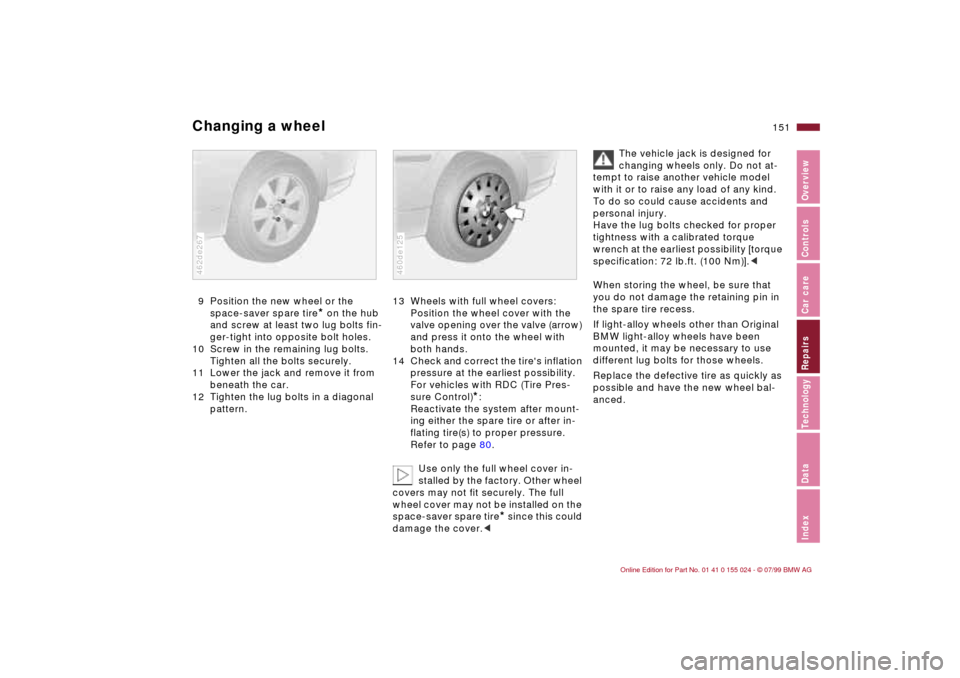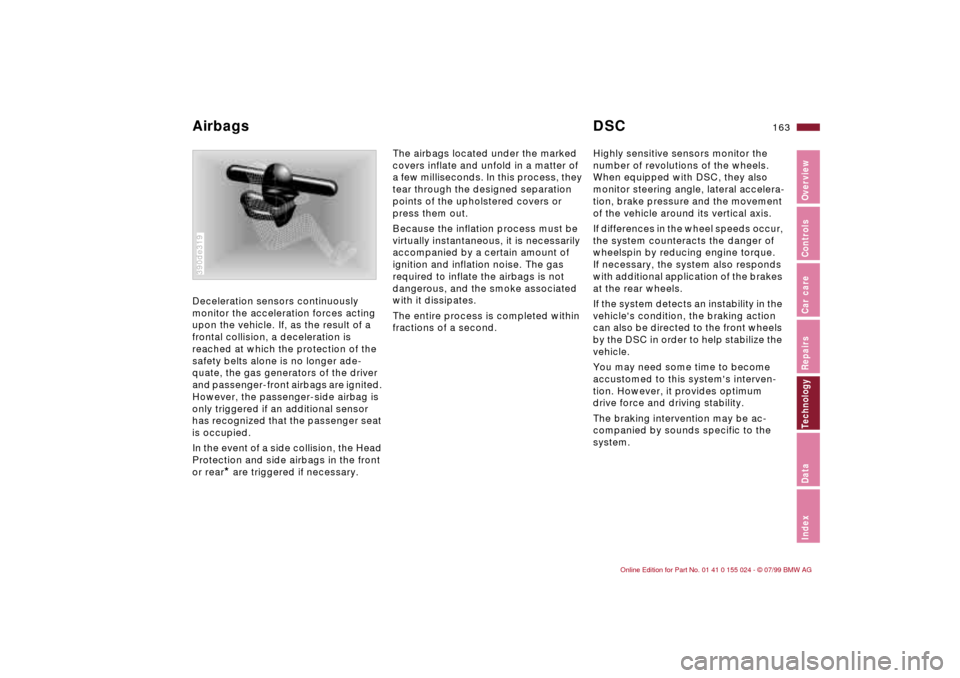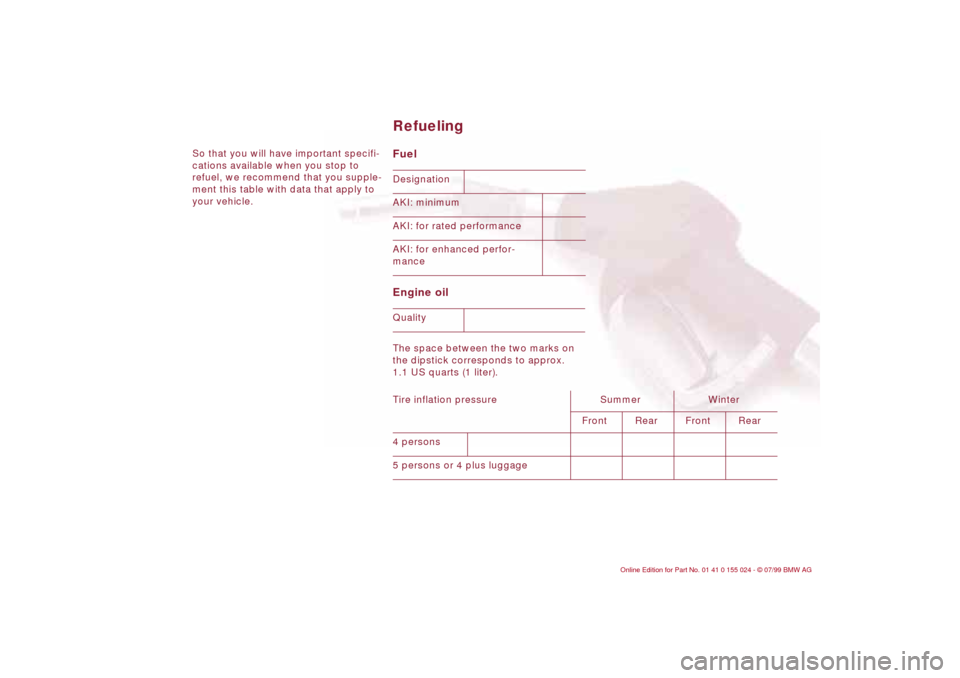2000 BMW 323i SEDAN inflation pressure
[x] Cancel search: inflation pressurePage 115 of 189

115n
IndexDataTechnologyRepairsCar careControlsOverview
Tire replacement Tire rotation
Do not use retreaded tires. Driving
safety may be impaired by their
use. This is due to the possible varia-
tions in casing structures and, in some
cases, to their extreme age, factors that
can lead to a decrease in their durabil-
ity.<
Tire ageThe date on which the tire was manu-
factured is indicated by the code on the
sidewall:
DOT ... 329 indicates that the tire was
manufactured in Week 32 of 1999.
BMW recommends the replacement of
all tires when the tires are no more than
6 years old, even if a tire life of 10 years
is possible.
Spare tires over 6 years old should be
used only in case of emergency. A tire
in this condition should be replaced by
a new tire immediately, and should not
be mounted together with new tires.
Between the axlesThe tread wear patterns at the front end
differ from those at the rear Ð the actual
patterns will vary according to individ-
ual driving conditions. In the interests of
safety and maintaining optimal handling
characteristics, tire rotation is not rec-
ommended.
If a proposed interaxle rotation of tires
is based on economic considerations,
one should consider whether the costs
for the rotation are likely to be recap-
tured by any increase in the service life
of the tires that might be realized. In
principle, interaxle rotation should be
performed in short intervals, with a
maximum of 3,000 miles (5,000 km).
Consult your BMW center for more
information.
Should you decide to rotate the tires, it
is essential to comply with the following:
Rotate tires on the same side only, since
braking characteristics and road grip
could otherwise be adversely affected.
Following rotation, the tire inflation
pressure should always be corrected.If different tire sizes are mounted
on the front and rear axles (refer to
page 118), the wheels may not be ro-
tated from one axle to the other.<
Page 117 of 189

117n
IndexDataTechnologyRepairsCar careControlsOverview
Winter tiresChoosing the right tireBMW recommends winter tires (M+S
radial tires) for driving in adverse winter
road conditions. Although all-season
M+S tires provide better winter traction
than standard summer tires with H, V,
W, Y and ZR speed ratings, they gener-
ally fail to provide the same levels of
performance as standard snow tires in
winter driving.
In the interest of safe tracking and
steering response, install winter tires
made by the same manufacturer having
the same tread configuration on all four
wheels.
Mount only winter tires approved by
BMW. Any BMW center will be glad to
provide you with information on the
best winter tires for your particular driv-
ing conditions.Never exceed the maximum speed
for which the tires are rated.
Unprofessional attempts by laymen to
service tires can lead to damage and
accidents.
Have this work performed by skilled
professionals only. Any BMW center
has the required technical knowledge
and the proper equipment and will be
happy to assist you.<
Tire condition, tire pressureWinter tires display a perceptible loss in
their ability to cope with winter driving
conditions once the tread wears to
below 0.16 inches (4 mm), and should
thus be replaced.
Comply with the specified tire inflation
pressures Ð and be sure to have the
wheel and tire assemblies balanced
every time you change the tires.
StorageAlways store tires in a cool, dry place.
Store them away from light whenever
possible. Protect the tires against con-
tact with oil, grease and fuel.Snow chains
*
The use of narrow-link BMW snow
chains on summer or winter tires is
approved only in pairs and only on the
rear wheels. Comply with all manufac-
turer's safety precautions when mount-
ing the chains.
Page 151 of 189

151n
IndexDataTechnologyRepairsCar careControlsOverview
Changing a wheel9 Position the new wheel or the
space-saver spare tire
* on the hub
and screw at least two lug bolts fin-
ger-tight into opposite bolt holes.
10 Screw in the remaining lug bolts.
Tighten all the bolts securely.
11 Lower the jack and remove it from
beneath the car.
12 Tighten the lug bolts in a diagonal
pattern.
462de267
13 Wheels with full wheel covers:
Position the wheel cover with the
valve opening over the valve (arrow)
and press it onto the wheel with
both hands.
14 Check and correct the tire's inflation
pressure at the earliest possibility.
For vehicles with RDC (Tire Pres-
sure Control)
*:
Reactivate the system after mount-
ing either the spare tire or after in-
flating tire(s) to proper pressure.
Refer to page 80.
Use only the full wheel cover in-
stalled by the factory. Other wheel
covers may not fit securely. The full
wheel cover may not be installed on the
space-saver spare tire
* since this could
damage the cover.<
460de125
The vehicle jack is designed for
changing wheels only. Do not at-
tempt to raise another vehicle model
with it or to raise any load of any kind.
To do so could cause accidents and
personal injury.
Have the lug bolts checked for proper
tightness with a calibrated torque
wrench at the earliest possibility [torque
specification: 72 lb.ft. (100 Nm)].<
When storing the wheel, be sure that
you do not damage the retaining pin in
the spare tire recess.
If light-alloy wheels other than Original
BMW light-alloy wheels have been
mounted, it may be necessary to use
different lug bolts for those wheels.
Replace the defective tire as quickly as
possible and have the new wheel bal-
anced.
Page 163 of 189

163n
IndexDataTechnologyRepairsCar careControlsOverview
Deceleration sensors continuously
monitor the acceleration forces acting
upon the vehicle. If, as the result of a
frontal collision, a deceleration is
reached at which the protection of the
safety belts alone is no longer ade-
quate, the gas generators of the driver
and passenger-front airbags are ignited.
However, the passenger-side airbag is
only triggered if an additional sensor
has recognized that the passenger seat
is occupied.
In the event of a side collision, the Head
Protection and side airbags in the front
or rear
* are triggered if necessary.
390de319
The airbags located under the marked
covers inflate and unfold in a matter of
a few milliseconds. In this process, they
tear through the designed separation
points of the upholstered covers or
press them out.
Because the inflation process must be
virtually instantaneous, it is necessarily
accompanied by a certain amount of
ignition and inflation noise. The gas
required to inflate the airbags is not
dangerous, and the smoke associated
with it dissipates.
The entire process is completed within
fractions of a second.Highly sensitive sensors monitor the
number of revolutions of the wheels.
When equipped with DSC, they also
monitor steering angle, lateral accelera-
tion, brake pressure and the movement
of the vehicle around its vertical axis.
If differences in the wheel speeds occur,
the system counteracts the danger of
wheelspin by reducing engine torque.
If necessary, the system also responds
with additional application of the brakes
at the rear wheels.
If the system detects an instability in the
vehicle's condition, the braking action
can also be directed to the front wheels
by the DSC in order to help stabilize the
vehicle.
You may need some time to become
accustomed to this system's interven-
tion. However, it provides optimum
drive force and driving stability.
The braking intervention may be ac-
companied by sounds specific to the
system.
Airbags DSC
Page 182 of 189

Everything from A to ZGlove compartment lamp
bulb replacement148
Gross vehicle weight174HHandbrake63
Handsfree system95
Hazard warning flashers25
Hazard warning triangle25
Head restraint48
Headlamp covers,
care132, 143
Headlamp flasher83
Headlamp washer
system124, 175
Headlamp washers70
Heated seats91
Heavy loads99
Height173
HiFi system Ð harman
kardon92
High beams23, 68, 83
bulb replacement143
Hood release120
Horn17
Hubcap150IIce warning76
Icy roads76
Identification, tires116Ignition key32
Ignition lock61
Indicator lamps20
Inflated pressure27, 113
Inflation pressure
monitoring80, 167
INSPECTION74
Installing a child restraint
system60
Instrument cluster18
Instrument lighting82
Instrument panel18
Interaxle tire rotation115
Interface socket96
for Onboard
Diagnostics139
Interference
cellular phones112
Interior lamps36, 83
bulb replacement147
remote control36
Interior motion sensor42
Interior rearview mirror52
automatic dimming
feature53, 165
Interlock61
Intermittent wipe68
JJack149
Jump-starting157
KKey Memory53
Keys32
with remote control32LLAMPS ON warning82
Lashing eyes99
Leather care136
Length173
License plate lamp
bulb replacement147
Light switch82
Light-alloy wheels118
Lighter96
Load-securing devices99
Louvers86
Low beam headlamps82
Low beams
bulb replacement143
Lug bolts150
Lug wrench149
Luggage compartment41
capacity174
floor mat41
floor panel41
remote control37
Luggage compartment
lamps
bulb replacement148Luggage compartment
lid39
emergency release39
securing separately39
Luggage compartment
lighting39
Luggage rack100
Lumbar support49
MM+S tires117
Maintenance74, 131
Malfunction displays75
Manual transmission64
Manually controlled
recirculated-air89
Memory50
MFL (Multifunction steering
wheel)24
Microfilter90, 155
Mirror memory50
Mirrors52
Mobile phones112
Modifications,
technical6, 138
Multifunction steering wheel
(MFL)24NNeckrest48
Page 184 of 189

Everything from A to ZSpeed display18
Speedometer18
Sports Seat49
Starting61
Starting assistance157
Starting problems105, 157
Starting the engine61
Steel wheels118
Steering111
Steering wheel lock61
Steptronic65
Stopping the vehicle62
Storage compartments93
Storing the vehicle137
Stroke172
Summer tires116
Sun visors52
Switching off the engine62
Symbols4, 153
Synthetic oils126TTachometer73
Tail lamp assembly
bulb replacement145
Tail lamps145
Tank capacity175
Technical data172
Technical
modifications6, 138Telephone
refer to the separate
Owner's Manual
Telephone hookup95
Temperature adjustment88
Temperature display
outside temperature76
Temperature gauge
engine coolant74
Temperature layering90
Third brake lamp147
Through-loading system97
Tilt alarm36, 43
remote control36
Tire codes116
Tire damage113
Tire inflation
pressure27, 113
Tire pressure
checking27
Tire Pressure Control
(RDC)80, 167
Tire pressure
monitoring80, 167
Tire replacement114, 115
Tire specifications118
Tire tread113
Tools142
Torque172
Tow fittings158
Tow starting158Towing158
Track173
Traction Control System
refer to DSC79
Transmission64
Tread depth, tires113
Trip odometer73
Trunk39
Trunk lid, refer to luggage
compartment lid39
Turn signal
indicator23, 68, 144
bulb replacement144
Turning radius173
Two-way radios112
UUsed batteries154VVacuum cleaner,
connecting96
Vanity mirror52
bulb replacement148
Vehicle battery152, 176
Vehicle care
exterior133
interior134
Vehicle identification130
Vehicle Identification
Number (VIN)130Vehicle immobilizer33
Vehicle painting133
Vehicle storage137
Vehicle weight174
Ventilation86
draft-free90
Vinyl care135
WWarning lamp "Please fasten
safety belts"21
Warning lamps20
Warning messages75
Warranty and Service Guide
Booklet131
Washer reservoir, filling124
Washing your car132
Water on roadways
deep water104
Waxing, paintwork134
Weights174
Wheel rims116
Wheelbase173
Wheels and tires116, 118
Width173
Windows, convenience
operation34
Windshield washer nozzle
adjustment124
Windshield washer reservoir,
filling124, 175
Page 188 of 189

So that you will have important specifi-
cations available when you stop to
refuel, we recommend that you supple-
ment this table with data that apply to
your vehicle.
Fuel
Engine oil The space between the two marks on
the dipstick corresponds to approx.
1.1 US quarts (1 liter). Designation
AKI: minimum
AKI: for rated performance
AKI: for enhanced perfor-
mance
Quality
Tire inflation pressure Summer Winter
Front Rear Front Rear
4 persons
5 persons or 4 plus luggageRefueling